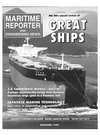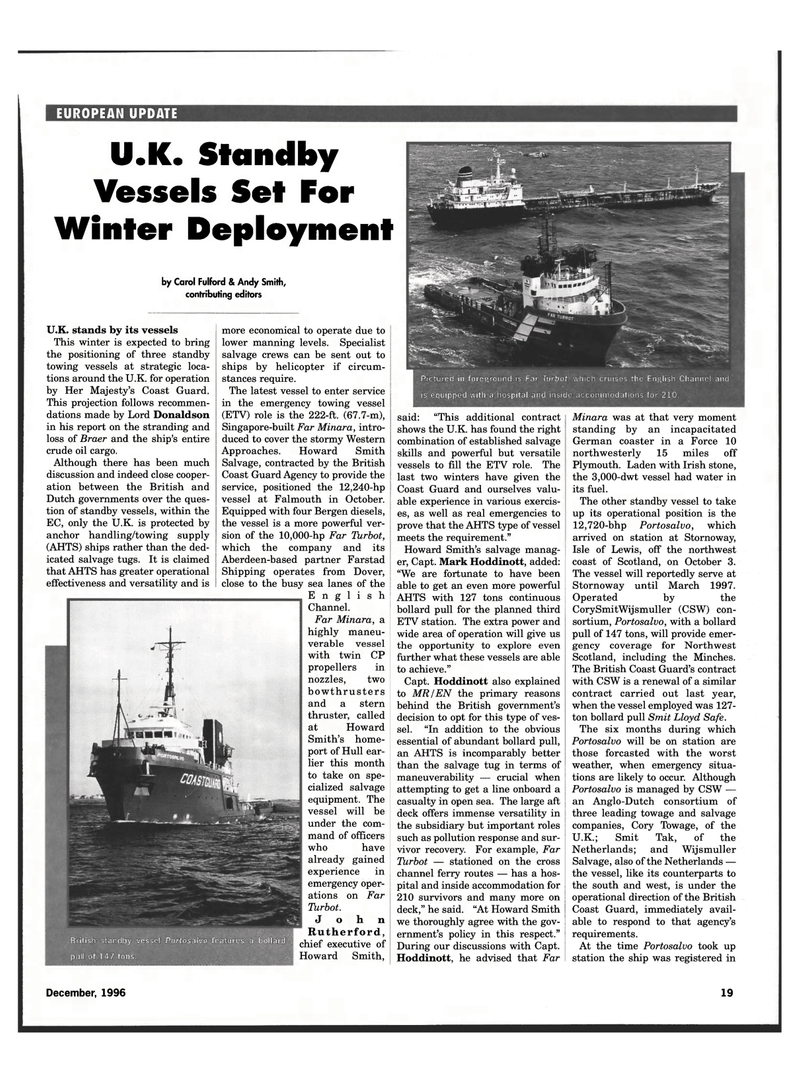
Page 17: of Maritime Reporter Magazine (December 1996)
Read this page in Pdf, Flash or Html5 edition of December 1996 Maritime Reporter Magazine
EUROPEAN UPDATE
U.K. Standby
Vessels Set For
Winter Deployment by Carol Fulford & Andy Smith, contributing editors said: "This additional contract shows the U.K. has found the right combination of established salvage skills and powerful but versatile vessels to fill the ETV role. The last two winters have given the
Coast Guard and ourselves valu- able experience in various exercis- es, as well as real emergencies to prove that the AHTS type of vessel meets the requirement."
Howard Smith's salvage manag- er, Capt. Mark Hoddinott, added: "We are fortunate to have been able to get an even more powerful
AHTS with 127 tons continuous bollard pull for the planned third
ETV station. The extra power and wide area of operation will give us the opportunity to explore even further what these vessels are able to achieve."
Capt. Hoddinott also explained to MR /EN the primary reasons behind the British government's decision to opt for this type of ves- sel. "In addition to the obvious essential of abundant bollard pull, an AHTS is incomparably better than the salvage tug in terms of maneuverability — crucial when attempting to get a line onboard a casualty in open sea. The large aft deck offers immense versatility in the subsidiary but important roles such as pollution response and sur- vivor recovery. For example, Far
Turbot — stationed on the cross channel ferry routes — has a hos- pital and inside accommodation for 210 survivors and many more on deck," he said. "At Howard Smith we thoroughly agree with the gov- ernment's policy in this respect."
During our discussions with Capt.
Hoddinott, he advised that Far
Minara was at that very moment standing by an incapacitated
German coaster in a Force 10 northwesterly 15 miles off
Plymouth. Laden with Irish stone, the 3,000-dwt vessel had water in its fuel.
The other standby vessel to take up its operational position is the 12,720-bhp Portosalvo, which arrived on station at Stornoway,
Isle of Lewis, off the northwest coast of Scotland, on October 3.
The vessel will reportedly serve at
Stornoway until March 1997.
Operated by the
CorySmitWijsmuller (CSW) con- sortium, Portosalvo, with a bollard pull of 147 tons, will provide emer- gency coverage for Northwest
Scotland, including the Minches.
The British Coast Guard's contract with CSW is a renewal of a similar contract carried out last year, when the vessel employed was 127- ton bollard pull Smit Lloyd Safe.
The six months during which
Portosalvo will be on station are those forcasted with the worst weather, when emergency situa- tions are likely to occur. Although
Portosalvo is managed by CSW — an Anglo-Dutch consortium of three leading towage and salvage companies, Cory Towage, of the
U.K.; Smit Tak, of the
Netherlands; and Wij smuller
Salvage, also of the Netherlands — the vessel, like its counterparts to the south and west, is under the operational direction of the British
Coast Guard, immediately avail- able to respond to that agency's requirements.
At the time Portosalvo took up station the ship was registered in
U.K. stands by its vessels
This winter is expected to bring the positioning of three standby towing vessels at strategic loca- tions around the U.K. for operation by Her Majesty's Coast Guard.
This projection follows recommen- dations made by Lord Donaldson in his report on the stranding and loss of Braer and the ship's entire crude oil cargo.
Although there has been much discussion and indeed close cooper- ation between the British and
Dutch governments over the ques- tion of standby vessels, within the
EC, only the U.K. is protected by anchor handling/towing supply (AHTS) ships rather than the ded- icated salvage tugs. It is claimed that AHTS has greater operational effectiveness and versatility and is more economical to operate due to lower manning levels. Specialist salvage crews can be sent out to ships by helicopter if circum- stances require.
The latest vessel to enter service in the emergency towing vessel (ETV) role is the 222-ft. (67.7-m),
Singapore-built Far Minara, intro- duced to cover the stormy Western
Approaches. Howard Smith
Salvage, contracted by the British
Coast Guard Agency to provide the service, positioned the 12,240-hp vessel at Falmouth in October.
Equipped with four Bergen diesels, the vessel is a more powerful ver- sion of the 10,000-hp Far Turbot, which the company and its
Aberdeen-based partner Farstad
Shipping operates from Dover, close to the busy sea lanes of the
English
Channel.
Far Minara, a highly maneu- verable vessel with twin CP propellers in nozzles, two bowthrusters and a stern thruster, called at Howard
Smith's home- port of Hull ear- lier this month to take on spe- cialized salvage equipment. The vessel will be under the com- mand of officers who have already gained experience in emergency oper- ations on Far
Turbot.
John
Rutherford, chief executive of
Howard Smith,
December, 1996 19

 16
16

 18
18
